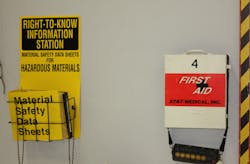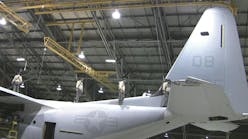Twenty years ago I was working on the 727 tail stand; someone yelled, “Something’s burning!” Soon, from my high vantage point, I saw a coworker running outside, a NiCad aircraft battery held in front at arm’s length – smoking. He set it on concrete to cool; later received a $25 award for his efforts. In my mind I pictured him at the future crew meeting, proudly accepting his check, his forehead and upper torso blistered with chemical burns; stumbling with the new cane that replaced his missing eyes; his shirt spattered with liquid skin from his melting face. And all I could think was:
WHAT … AN … IDIOT!
We all react differently to events; we are geared to protect; it’s our nature. I don’t think my friend acted incompetently nor did he need a spare 25 bucks; he recognized a threat and acted. He could also have disconnected the battery with little to no risk of splashing should the battery explode.
We should stop and think before acting or our next event is our funeral. Enough time has passed; we need to revisit the chemical dangers of our job. And to follow up on my misguided friend I will revisit my own infamous Darwin Award moment. It seems fair.
Replacing a fuel pump
I was replacing a 727-100 #2 tank fuel pump in a field line station before the deferral expired. The tanks contained a ‘ramp load’, a pre-final fuel load put on when it arrived. The oval underwing panel was removed and I closed the manual shut-off valve to maneuver the pump out. It’s said that bad things happen in threes; I was already zero for two that day.
In a line station, one does not have the convenience of emptying the fuel tank before maintenance. The #2 tank contained about 15,000 pounds of fuel. Once the pump cleared the mounting Jet-A began evacuating in my face at the rate of one Lake Superior per second; think Curly Howard trying to turn off a firehose. I tried unsuccessfully to shove the pump back in place against the Jet-A tsunami. Oh, the humanity!
Now you would think I’d take my toys, go home, take a shower, and sleep off the night. But an airline line station cannot be walked away from; I was there for five more hours until the last launch. I showered and changed clothes, but the damage was done. My clothes were destroyed; the airport fire department used them for extinguisher practice. I shaved my head and beard. The remaining fumes were so bad my wife insisted I sleep in another room … two states downwind.
It’s easy to laugh about it now, but for weeks I suffered second-degree chemical burns over 80 percent of my body. My eyes and ears had to be flushed. For days I could not be rid of the fumes that continued to absorb into my bare skin – not just the liquid fuel, but the Jet-A as a gas; your skin ‘breathes’ and petroleum-based liquids are quick to absorb. The doctor prescribed special burn ointments for several weeks.
Now that’s just good old Jet-A. There are other more hazardous materials, some very subtle, but dangerous. For there are other ways to ingest chemicals.
Beware of the unlisted ingredients
Ever wonder why pre-grated cheddar cheese doesn’t bunch up, yet when you grate cheese, it clumps in the refrigerator? (Yes, you did; you know you have.) The reason is: pre-grated cheese has a secret ingredient; it’s mixed with inert powders, e.g. processed cellulose or antifungal agents, to prevent the cheese shreds from sticking together. Yummy!
It’s been years since I deiced airplanes. When I was working in Newark airport in 2000, the truck manufacturers were introducing a closed bucket deicer to spray the aircraft; it keeps the ‘bucket’ person from the elements and out of the steam. This story is aimed at deicers still using the open buckets and their drivers. It also applies to deice fluid more than anti-ice fluid.
Years ago I wrote a graduate degree research paper on deicing fluid … yeah, I did. According to the Material Safety Data Sheet (MSDS) the basic compounds that deice fluid manufacturers are required to report are pretty innocuous. Although not a dessert topping, glycol has a sweet taste; if consumed orally, the worst conditions you suffer from are gastrointestinal difficulties – enough said.
However, what is important is what the deice fluid MSDS does not say about is its own secret ingredient. Some manufacturers employ lubricants mixed in with the deice fluid. At the time of my report the lubricant was called methylbenzotriazole (MeBT), aka tolyltriazole. Per the Society of Environmental Toxicology of Chemistry, MeBT inhibits metal corrosion; its purpose is to lubricate the deice truck’s internal components, e.g. pumps, gears, etc.; it prevents hot water/fluid mixture damage. MeBT ends up in the deice steam cloud as it exits the truck’s nozzle. The reason that MeBT does not show up on the MSDS is because for proprietary reasons they are not required to list it; its chemical formula could be copied by competitors.
Now here’s the rub: MeBT is a carcinogen; in plain words, it is a cancer-causing agent. The good news is that it’s harmless if rubbed in pure form on your skin and you’d have to drink it by the gallon for it to be harmful by swallowing it. However, the bad news is it can be very harmful if ingested directly into the lungs in an atomized or aerosol form, like in steam.
We’re exposed to many dangerous chemicals, e.g. explosive squibs (solids), Skydrol (liquids), and aerosol fumes (gaseous). There’s no shame in using safety equipment for eyes (safety glasses), skin (plastic gloves) or lungs (breathing masks). The only thing you should hold at arm’s length while running is a football, to be played with your children that you see and hear (thanks to safety equipment) as they tackle you. Oh, that muscle soreness? That’s old age. You can’t prevent that.
OK, lecture’s over; Chem class is excused.





